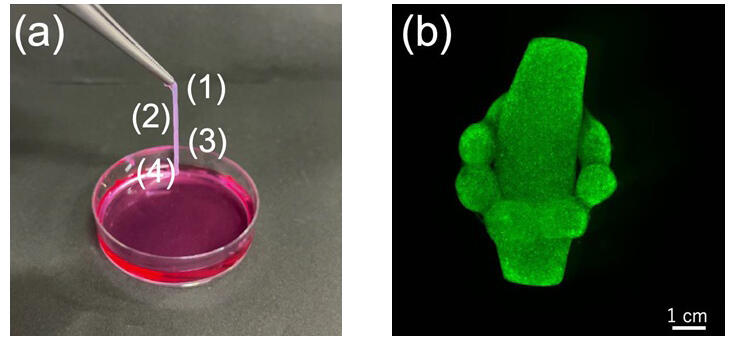Graduate Student Ayaka Kadotani of the Department of Biomedical Engineering, Graduate School of Engineering and Associate Professor Daisuke Yoshino of the Division of Advanced Applied Physics, Institute of Engineering at Tokyo University of Agriculture and Technology, in collaboration with Senior Researcher Gen Hayase of the National Institute for Materials Science (NIMS), have announced that they have established a method for fabricating basic organoid units mimicking glomeruli, which are responsible for kidney function, and confirmed the feasibility of combining the units to reproduce complex organ structures. They demonstrated the possibility that the combined units mature as tissues. This achievement is expected to contribute to the development of kidneys for transplantation and full-sized human kidney organoids. The results were published in the international journal APL Bioengineering on November 26.

Images were created by Yoshino et al. with modifications from figures in (Kadotani et al, 2024. APL Bioengineering, 8, 4, 046112) (Tokyo University of Agriculture and Technology)
There is a chronic shortage in the availability of organs for transplantation compared with the number of people require a transplant. Organoids based on three-dimensional culture technology are expected to be alternatives for this process because they partially mimic the structure and function of human organs. Organ structures are divided into parenchyma, which exerts organ-specific functions, and interstitium, which supports the parenchymal structure and controls its functions. Both parenchyma and interstitium need to be reproduced in transplantable organoids to have organ-like structure and function. Conventional kidney organoids have mostly reproduced only the parenchyma and were immature and small in size.
In this study, the research group envisioned a novel method to assemble kidney organoids, like toys such as building blocks or bricks. The organ is divided into basic units (elements) based on structure and function, and these units measuring several millimeters in size are fabricated. Finally, the units are assembled to construct a full-sized kidney organoid. This method is expected to allow for more efficient scaling up of organoids compared with conventional methods.
The researchers have already succeeded in fabricating organoid units with complex shapes, such as cylinders, spherical shells, and beads. They have confirmed that the fabricated organoid units can be stacked and assembled three-dimensionally to easily reproduce complex shapes and also that a microscopic vascular network connecting the organoid units was formed by vascular endothelial cells when multiple glomerular tissue-like organoid units were assembled using a protein solution containing vascular endothelial cells.
This result demonstrated the possibility that organoid units interact with each other via the vascular network and mature as a complex tissue. Moving forward, the research group aims to construct full-sized kidney organoids by properly arranging various units and stimulating cells to induce maturation. The next challenge is to build a vascular network.
Kadotani said, "This study is an important step toward the realization of a science fiction-like world in which 'organs are created by human hands.' Conventional iPS (induced pluripotent stem) cell-derived organoids were developed with the focus solely on function and could only mimic organs in the fetal stage. We believe that we can get closer to more advanced reproduction of biological tissues by remembering that 'the shape of an organ creates its function' while advancing our research. Moving forward, we would like to work on the 'construction of a hierarchical vascular network,' which is an important challenge in regenerative medicine."
Journal Information
Publication: APL Bioengineering
Title: Geometrically engineered organoid units and their assembly for pre-construction of organ structures
DOI: 10.1063/5.0222866
This article has been translated by JST with permission from The Science News Ltd. (https://sci-news.co.jp/). Unauthorized reproduction of the article and photographs is prohibited.




